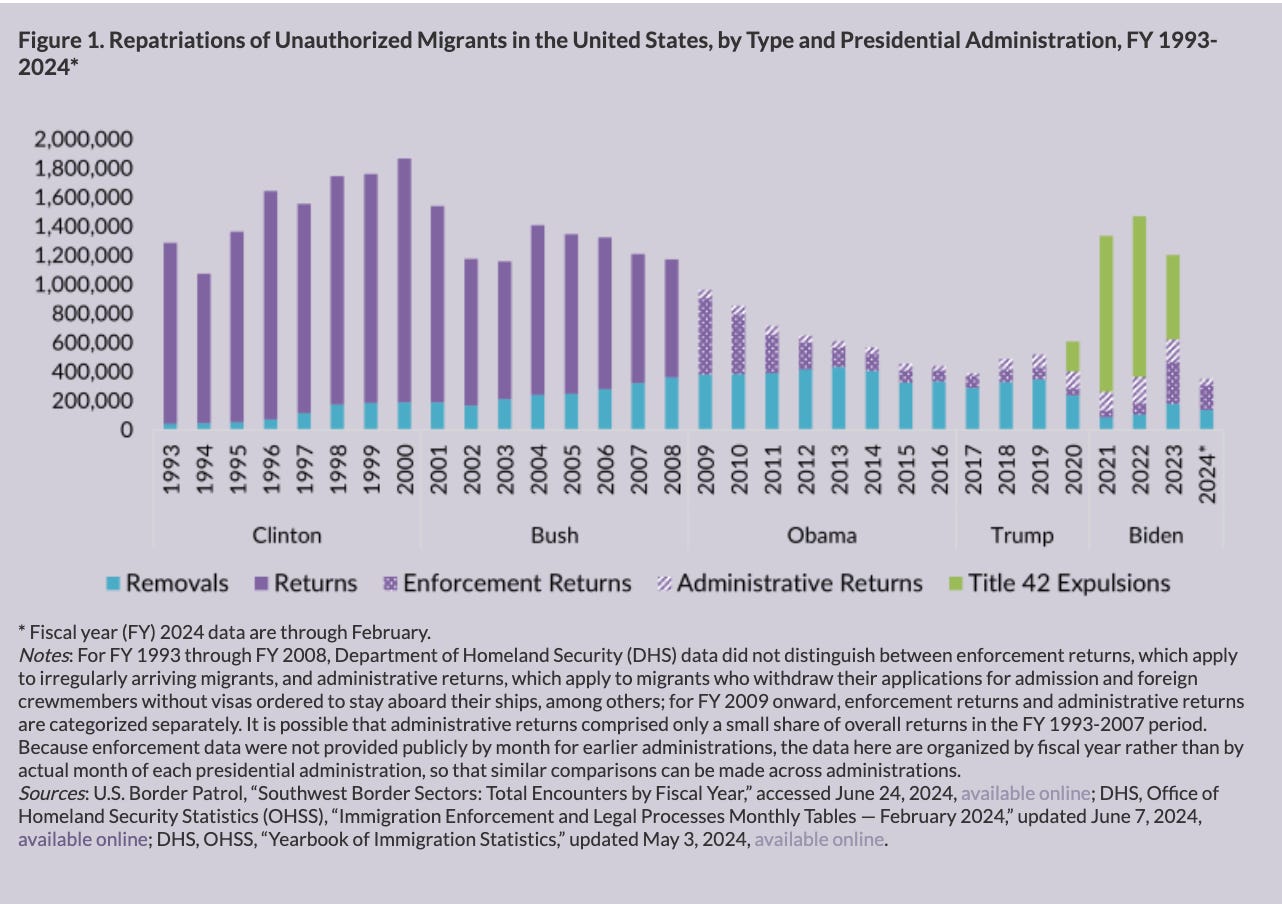Liberals don’t have to lose on immigration
“Moderating” on immigration doesn't mean abandoning it

When I first got ahold of a U.S. passport, two years after my family graduated from green card holders to full-fledged American citizens, I clung to it like a lifeline. Even now, when I travel, friends will laugh at me for obsessively checking for “my documents!” and my father still alerts various U.S. embassies of my travels.
Every July 4, I go to the National Archives. I walk through the exhibits of countless Americans who fought to ensure this country lived up to its ideals, and I listen to a reading of the Declaration of Independence as I push through the crush of tourists to examine the document for myself.
I don’t feel like I’m observing someone else’s history — I know that I’m basking in my own. I am the most patriotic person I know, except for perhaps millions of other people who can see themselves reflected in these anecdotes.
Immigrants, for the most part, are deeply grateful to be in the United States, and almost by definition are willing to make deep sacrifices to come here. They risk life and limb, cultural exclusion, even the possibility that their children will not know their language or culture. Immigrants have already accepted that there are risks on the road to becoming an American. It’s a fact that I think my fellow liberals often lose sight of when instead it should be central to how we think about solving the politics of the issue.

Without immigration, America is destined for economic decline. The problem is the backlash to Biden’s border chaos helped re-elect Donald Trump, seemingly with the mandate to pursue widespread deportations. However, after witnessing the brutality of what a mass deportation campaign actually looks like, Americans have decided that while it may have sounded good in theory, they don’t actually like the praxis.
I worry that many liberals could take this to mean we don’t need to address the very real democratic backlash to immigration, that we can outsource everything to the thermostat of public opinion. I also worry about the competing strategies on offer which currently range from insufficient to downright counterproductive. Pro-immigration moderates have allowed the political possibilities frontier to be set by our current president, limiting themselves to an immigration agenda that basically consists of Trumpism with woke characteristics (Crack down on immigration! Moderate! Close the border! But, like, not in a mean way).
There’s a better path.
The promise made by the mass deportation right was that they would bring law and order back to the United States. Trump promised to get rid of criminals, stop the border chaos, and restore a sense of national control to our immigration system.
Well, do things feel orderly now? ICE agents allegedly held a 15 year old American with special needs at gunpoint outside a high school after mistaking him for an MS-13 pledge. A graduate student who wrote a mild op-ed in her student paper was picked up in the middle of the street by a group of masked plainclothes officers. The surveillance footage looks like an abduction.
Liberalism has the opportunity to co-opt much of the restrictionists’ political ground by building an immigration system that meets our economic needs while being responsive to the democratic will of the voters. To do so, we need to stop ducking the problem.
Where do workers come from?
Without immigration, the U.S. will face shortages of construction workers, skilled laborers, and innovators needed to construct millions of homes, rapidly expand clean energy, and retain our place as the world’s technological frontier. Without immigration, growth will slow, and our ability to fund a welfare state will depend on the politically toxic project of significantly higher taxation. None of this is particularly controversial:
Housing
To fix our housing shortage, we need to build somewhere in the ballpark of 4 million to 20 million homes; YMCMV (your modeling choices may vary).1 Common sense tells us that the U.S. construction industry will simply not be capable of producing that volume of homes without more immigrant workers, given that one-third of craftsmen come from outside the United States.2
A 2024 study looked at the 2008 rollout of the Secure Communities program, which deported more than 300,000 undocumented immigrants in five years. It found that three years after the rollout, the average county (roughly 500,000 people) had “foregone the equivalent of an entire year’s worth of additional residential construction.” As a result, the average new housing construction was 18% more expensive.3
Energy
Electrification is incredibly labor-intensive. One estimate ranges that 4.2 million to 6.5 million new jobs will be created by 2035 due to demand for construction workers, battery manufacturing workers, and advanced building electrification workers, among others.
In a weak economy, with lots of people sitting around unemployed, finding people to hire for those roles wouldn’t be much of a challenge. But when the economy is near full employment, like today, it’s a different story.
It’s not sufficient to say, “Americans can just do those jobs,” because Americans are already working in other, equally important jobs. Yes, productivity increases can help alleviate the problem in some industries (we’ve seen this with farm workers and the increased mechanization of agriculture), but in labor-intensive industries like construction, skilled manufacturing, health care, day care, housekeeping, etc … productivity improvements can only do so much. You need more people.4
Innovation
Let me be the millionth person to point out that lots of inventors are immigrants or children of immigrants. Immigrants are responsible for almost 25% of the nation’s innovative output, and if you count all of the collaboration they do with U.S.-born inventors, they’re “directly or indirectly responsible for 36% of U.S. patent outputs” from 1990 to 2016.
But the thing is, it doesn’t really matter if I can share with you 1,000 studies showing that I'm right on the policy merits if the voters simply disagree. And that’s where liberals are very much in trouble.
How not to moderate on immigration
A liberal solution to the problem of immigration has to do two things: It has to provide an answer for how America’s labor force will achieve its technological, demographic, and taxation needs, and it has to be democratically responsive. There are more or less three “solutions” that have been proffered so far, all of which fail one or both of these requirements:
David Leonhardt-ism
This is presently the most-common view held by political centrists about the correct path forward on immigration. Their view — what I’m shorthanding as “Leonhardt-ism” — is that the central problem is the sheer number of immigrants.5
Leonhardt, one of the most influential journalists in America as an editorial director for The New York Times Opinion, has not, to my knowledge, publicly stated what he believes to be the optimal level of immigration. However, he has repeatedly emphasized the sheer number of immigrants who entered the U.S. under Biden and praised Denmark for seeking lower levels of immigration.
The best clue we have about Leonhardt’s preferred level of immigration is his frequent praise of the low immigration levels of the late 1960s, when the foreign-born share of the population hovered around 5%. Achieving this today would mean not only halting all new immigration, but deporting roughly 35 million people.
This easily fails the economic growth and well-being test, but it also fails the democratic responsiveness test.
The backlash to immigration was not tied to specific numbers.
Chicago, which buckled under the weight of 35,000 immigrants from across the southwest border, barely blinked when it absorbed 30,000 Ukrainians mere months earlier. You can also look to Europe — just 37,000 migrants crossing the English Channel in 2024 led to a massive political backlash in the U.K., yet from 2021-2023, Spain absorbed more than 3 million migrants from outside the European Union and “backlash has been strikingly muted.”
These facts are simply not consistent with Leonhardt’s view of immigration politics. It suggests that people react strongly against the chaos of unexpected arrivals being dumped unceremoniously in their neighborhoods, coming over on boats like an invasionary force, sleeping on streets and on the floors of police departments, and draining their local political system’s time, attention, and money. Under the wrong conditions, even a few thousand immigrants could create this kind of backlash.
The high-skilled immigration hack
I have a lot of sympathy for the folks working on high-skill immigration reform and view this as a necessary but insufficient project. Yes, we can and should entice the best and brightest the world has to offer to come to the U.S. But I’m worried that some proponents view this as a get-out-of-jail-free card for solving the broader immigration puzzle.
Doctors, scientists, and machine-learning engineers are great and a key part of what this country needs. But they don’t solve our demographic problems, and they exclude the construction and electrification sector workers we desperately need. It will be a generational failure of liberalism if we decide the only immigrants we’re willing to defend are ones who can qualify for H-1B and O-1 visas.
Obama 2012-ism
This is the “sound mean to immigrants” strategy and it’s not entirely without merit — but I think it only worked because the labor market wasn’t doing too hot. Even by Obama’s second term, the employment rate for prime-age workers was well below full employment. Demand for labor just wasn’t pulling in that many people.
Clearly, Obama was able to get the reputation of deporter in chief despite repatriating way fewer immigrants than Biden, Bush, or Clinton. But I doubt this strategy would have been sufficient if the U.S. labor market was pulling in millions more workers.

How to moderate on immigration without destroying the country or throwing immigrants under the bus
I’m an abundance liberal, so I look at the problem of immigration and see a lot of similarities to other pro-growth problems like housing development: concentrated costs and diffuse benefits. With housing, the costs are construction, congestion, and uncertainty. With immigration, the costs are both spatially and temporally concentrated.
First, while mountains of evidence demonstrates the economic benefits of immigration, there are real, unavoidable fiscal costs associated with bringing in new people. Immigrants tend to be younger, but that includes kids, who are the biggest fiscal burden on local communities (more than $15,000 per pupil in fiscal year 2022). Further, if the current work authorization policy remains, some new entrants will go six months without being able to legally work.
Abundance liberalism is about creating pro-growth constituencies. What better way to do this than to take part of the tax benefit that immigrants provide and provide bonus federal dollars to places that take immigrants? This would insure localities against the short-term costs of new entrants. Crazy idea, right?
Actually, no; this would just be expanding an already-existing program run by the Office of Refugee Resettlement that provides grants to offset resettlement costs over a very limited period of time while immigrants achieve self-sufficiency. In November 2023, 139 mayors, both Republicans and Democrats, asked the Biden administration to do exactly this.
But we could also go much further. One idea might be to tax immigrants themselves at higher rates and restrict federal benefits until immigrants have met some threshold of tax payments or achieved permanent residency.6 This is not a prospect that brings me joy. But I do think that these are necessary preconditions to warming the public to the idea that the economic math of immigration works out in our favor.
The second step is investing in the necessary state capacity to actually manage high levels of immigration. One of the most frustrating pieces of journalism from the Biden era was from Reuters, which reported that in 2021 and 2022 Biden officials “rejected a proposal to transport some migrants to other U.S. cities because the White House did not want ‘full ownership’ of the issue.” Well, I’m really glad they avoided facing full ownership of the problem!7
Let’s acknowledge here that the single biggest barrier to developing the appropriate state capacity to run a competent immigration system is the Republican Party and Donald Trump. But also … liberals (myself included) were too complacent after the widespread and popular backlash to Trump’s first-term cruelty. Policymakers were — somewhat reasonably — not adequately prepared for what a roaring labor market, the end of the COVID-19 pandemic, and social media were going to do.
Well, now we know.
The final step is that liberals need to get patriotic about immigration. In concrete terms, that means we should invest in assimilation classes and play up English-language requirements.
Neither of those ideas is much of a sacrifice. Almost 84% of immigrants who arrived in 2017 spoke at least some English, according to the American Immigration Council. Back in 1907, the Ellis Island days, nearly half of all immigrants spoke no English at all.
This is not a complete solution to the politics of immigration, but it is a framework for how pro-immigration forces need to think about the problem.8
Immigration is the core political issue of our time — will liberals confine ourselves to merely defending the Katalin Karikós of the world? Will we accept the postliberal framework that the American experiment is nothing special, just another country full of people who define themselves by where their ancestors are buried? Failure is an option, one that will leave us impoverished, stripped of our democratic freedoms, or both.
These models are from 2019 to 2020, the problem is likely even worse today.
Skipping mass transit so as not to be repetitive, but yes, you need construction workers to build trains too. I'll also note that density is a prerequisite for a high-quality mass transit system.
That’s about 2,500 fewer homes permitted and 2,000 fewer newly constructed homes entering the market. The price impact is even after controlling for the fact that the homes produced are smaller due to workforce shortages. Also, to preempt the coming Oren Cass screed about how we're all raging neoliberal shills who care not for U.S.-born workers, the study found that immigrant and domestic labor were complements. That is, immigration enforcement leads to a decline of almost 600 native workers for the average county! (Come on, Oren, I dare you to do Mad Libs, I know you're reading this.)
Furthermore, as research has shown, native-born workers and immigrants tend to specialize in different types of tasks (manual-physical labor skills vs. communication-language tasks).
This view deserves — and will receive — its own column-length treatment.
Many immigrants do face significant restrictions on access to federal benefits but there are many exceptions.
This is sarcasm.
I do not pretend that a magical set of policies can eliminate opposition to immigration and usher us into a golden age of liberalism. But I also don’t think that’s the standard we should hold ourselves to — remember, Trump only won a second term by 1.5 percentage points.



While I like your ideas, they don’t address the elephant in the room: illegal immigration. When I talk to normies who don’t follow politics closely, even those who vote for Democrats, I find many of them are bothered by the high levels of illegal immigrants in the country, by sanctuary cities, and by Democrats’ perceived (or actual) lack of interest in immigration enforcement. To them, it feels inherently disorderly and unfair.
So I do think a return to Obama’s first term policies and PR on the issue makes sense politically, and is probably necessary.
You left out a CRITICAL distinction: illegal immigration vs legal. My sense is that the majority of the public is against illegal immigration but much more nuanced about legal immigration. The problem is, the Biden administration screwed up royally by allowing what was perceived to be unfettered illegal immigration and the backlash has affected all immigrants. Then Biden claimed there was nothing that he could do about the border absent Congressional action. Well, Trump proved that was not true. I think that if a candidate wants to win in 2028, she or he will have to continue Trump's border policies.